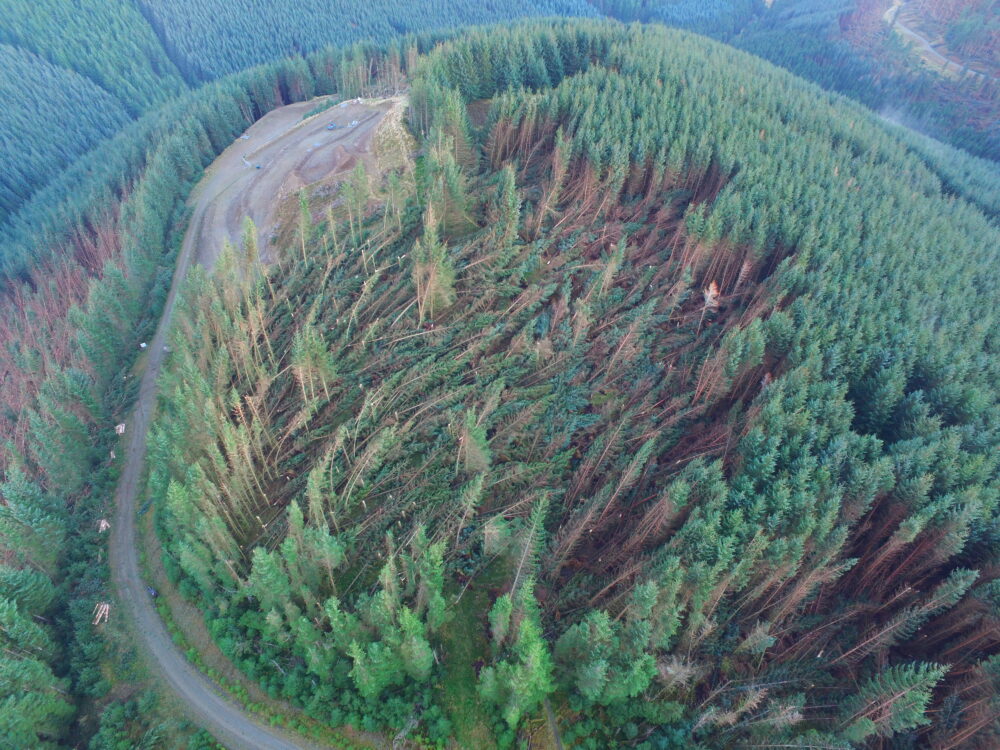Meetings have already taken place between the organisations to start planning the recovery of at least 4,000 hectares of woodland that have been affected by the storm.
A new mapping tool, developed by Forest Research and Scottish Forestry, will be invaluable in the recovery process.
For the first time, woodland managers will be able to use the satellite data to get an initial understanding of where the damage has occurred, without the immediate need for extensive and potentially risky site visits.
The most intensive damage to Scotland’s woodlands runs down the east coast, across the Borders and East Lothian, stretching into Galloway. Another swathe of damage runs through Banffshire, Aberdeenshire, Kincardineshire, Angus and into Perthshire.
Environment Minister Màiri McAllan said:
“Storm Arwen provided a salutary lesson of the power of nature and the challenge of climate change. Our people suffered and so, too, did our natural environment.
“The impact is evident in the distressing images of flattened forests and woodlands which will take decades, if not centuries to recover from. Their loss reminds us of the significant role trees play in our lives, communities, economy and wellbeing.
“Behind this is a monumental clear up operation which is being undertaken by large and small woodland owners. Whilst this is being carried out, the message to the public is not to enter into affected forests until they are made safe.
“Forestry might be a long term business, but getting to grips with managing the windblown timber has already begun. As more accurate information becomes available, Scotland’s forest industry will be taking decisions on handling the extra volumes of timber that needs to be harvested.
”Through Scottish Forestry, advice, information and assistance is being made available to woodland owners and the forestry sector to help manage the aftermath of Storm Arwen.”
The spatial data, and more detailed analysis to come, will help the sector with practical issues such as planning which roads can be used to take the greatest amount of timber out of the most affected forests.
More work is being carried out to put accurate estimates on the amount of hectares and volume of timber affected. Helicopter surveys and ground-based surveying will also add accuracy to the data being gathered to help the sector work together in a strategic and collaborative way.
Andy Leitch, Deputy Chief Executive of Confor, the trade body for forestry and wood-using companies, said:
“With new information emerging every day about the impact of Storm Arwen – from satellite data, localised aerial surveys and on-ground observation – it is vital that the industry and the public forestry bodies work together as closely as possible.“The most effective way to ensure windblown trees are removed safely and quickly is to share information, identify opportunities for joint approaches – and deploy resources where they are most needed.
“The clean-up after the storm – and the work needed to remove the windblown timber, make safe the remaining trees and get the timber to wood processors – will take time and effort. However, Confor is fully committed to working in partnership with the public forestry bodies to make that happen in a speedy and efficient manner.”
Scottish Forestry, Confor and FLS will continue to work closely at both national and levels, taking into account the different timber markets.
Scottish Forestry has already deployed its staffing resource to the areas most affected, anticipating that woodland owners in the areas affected will require advice.
Action to fast track and simplify the paperwork around Felling Permissions and Forest Management Plans has been undertaken to help woodland managers tackle trees that were affected by windblow.
FLS began discussions with its timber customers straight after Storm Arwen hit to determine market availability, volume requirements and species demand. The agency, which manages the national forests, is also compiling more detailed information on areas, volumes, species and damage types in order to prioritise areas for harvesting and sale.
FLS has considerable experience in dealing with similar challenges and its long standing customer partnerships will provide strong support and assistance in repairing the damage caused by the storm.
Most of the trees that have been flattened will be removed over the next year and sent to wood processors across Scotland. In time, the forests will be replanted.



